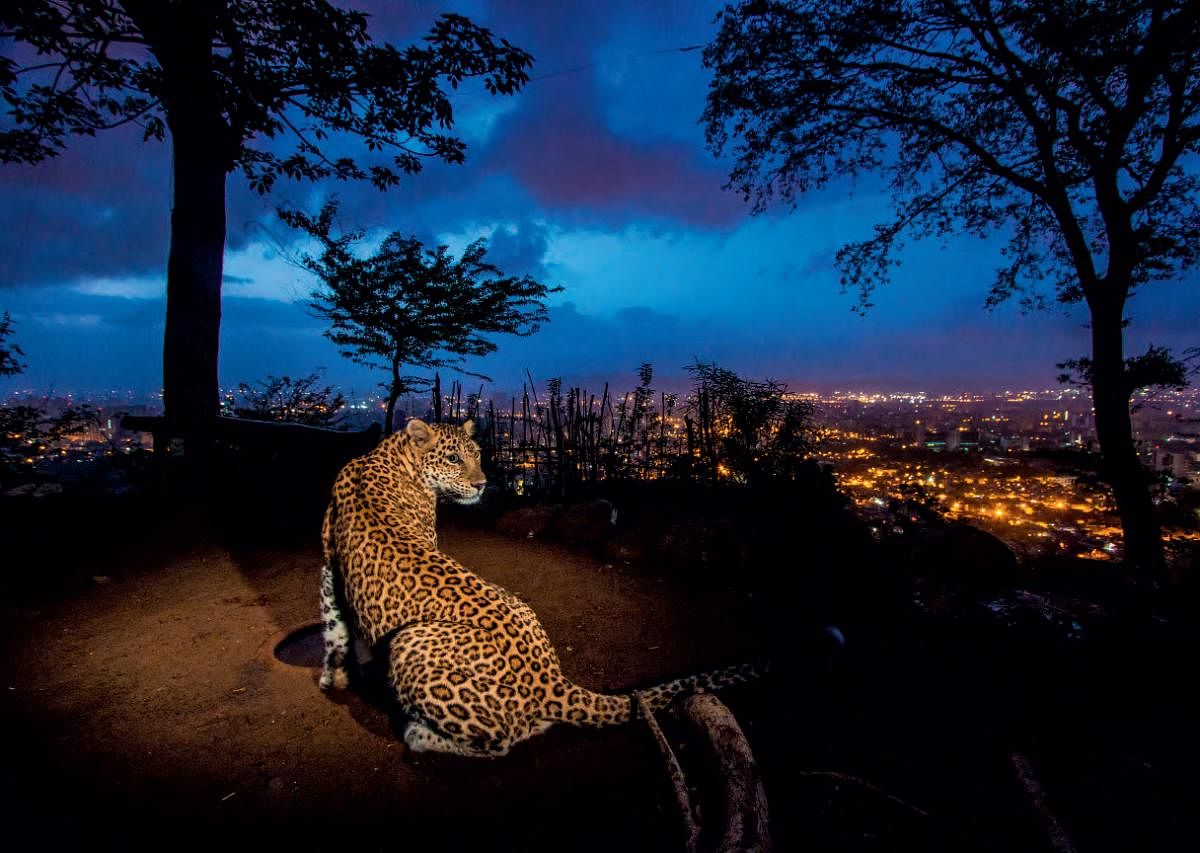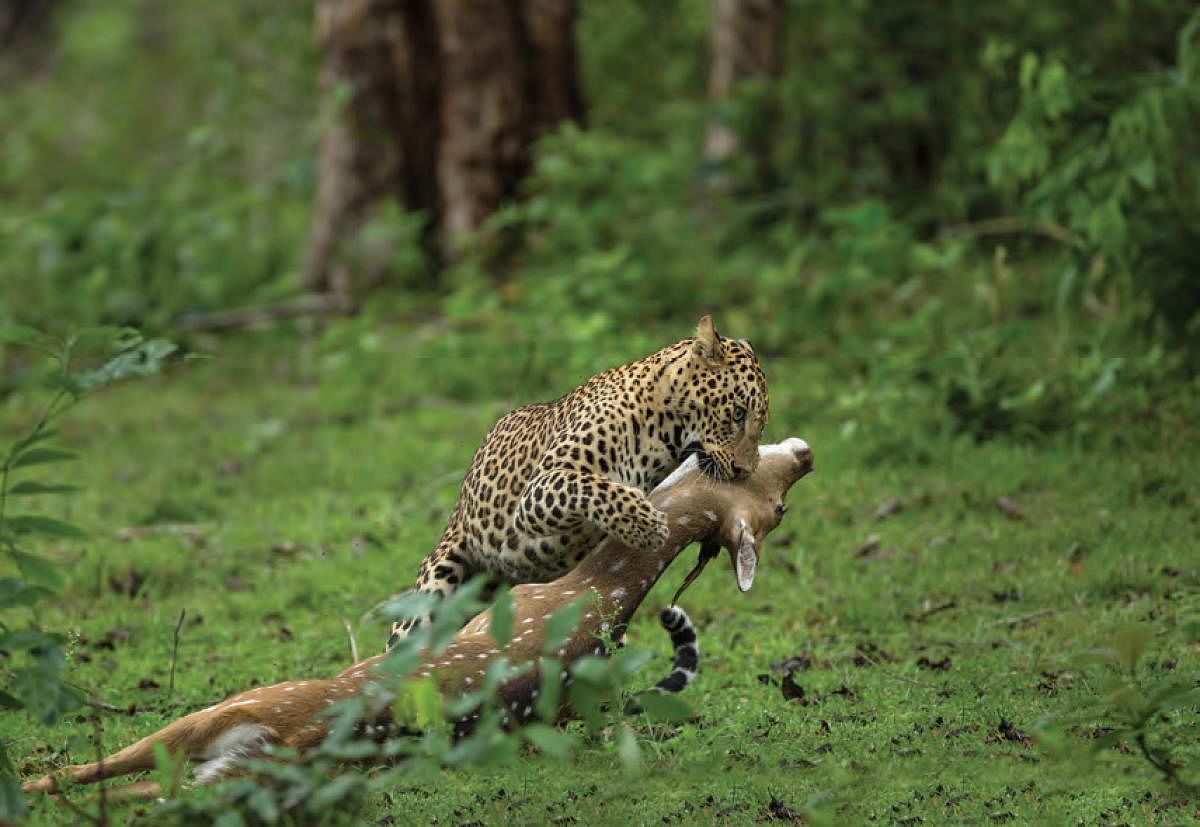

A young leopard carrying a bandicoot for his sundown snack, a leopardess with a broiler chicken in her mouth, another leopard walking away with a langur locked tightly between his canines, one carrying a puppy, another clutching on to a barking deer: these were the photographic glimpses of these cats’ daily menus from our camera trapping exercise.
Leopards are diet generalists, meaning they can feed on any kind of meat and on prey of any size. Unlike tigers, which prefer large-sized prey species, such as the gaur, the sambar deer, or the daintier chital, leopards’ diet consists of prey species of varying sizes, depending upon where they live. They also lack the strength and the weight of a tiger to bring down larger animals like gaur, though they are occasionally known to kill very large prey.
In protected areas where large-sized prey are plentiful, leopards go after chital, sambar, barking deer, the young ones of wild pig, four-horned antelope, and other similar large or medium-sized prey. In areas where such large-bodied prey animals are rare, they sustain themselves with small-sized prey such as the bonnet macaque, the langur, the black-naped hare, the jungle fowl and the peafowl.
Studies from Namibia have even shown that female leopards feed on a wider range of smaller prey species, as they need lesser energy compared to their male counterparts due to their smaller body size. According to the researchers, the females are more restricted in their movements, especially when rearing cubs, and hence this compromise is necessary. Males, with larger home ranges, can find more options and so are more selective.
Analysing whiskers
The researchers arrived at these conclusions through an interesting study. They analysed leopard whiskers by measuring the composition of stable isotopes of carbon and nitrogen found in them. When a leopard consumes prey, the isotope composition of the animal it has fed on is assimilated into the leopard’s body and even in its whiskers depending upon the relative abundance of its overall diet. This allowed the scientists to study the leopard’s main diet and the variety of prey it may have consumed.
The researchers cut off one whisker each from eighteen adult female and eighteen adult male leopards, chopped them into smaller segments of five millimeters and analysed the stable isotope ratios. As leopard whiskers grow at a rate of 0.65 millimeters a day, each segment of the whisker would correspond to approximately eight days of feeding. The 8–10 cm long whiskers allowed the researchers to create a ‘feeding history’ of approximately 150 days. An interesting foray would be to conduct a similar experiment on men. Would it give any hint at varying diet (both solid and liquid) between weekdays and weekends? Would the diet on weekends be more spirited?
Though leopards are not choosy shoppers, large individuals cannot survive on small prey.
On an average, leopards must eat up to five per cent of their body weight each day, which for the biggest leopard comes to about 4–5 kg. This amount can be met by feeding on a four-horned antelope or a chital once in every two or three days. Then why would a chital-chasing, porcupine-fighting leopard switch to livestock? It’s like switching from eating healthy salad to risky junk food.
When these packages of meat no longer wander the leopard’s habitats then they must look elsewhere for their food. Livestock is perhaps one of the easiest ways to meet their dietary requirement.
This conflict had its beginnings thousands of years ago. Archaeological evidence indicates that livestock was introduced over ten thousand years ago in the fertile valleys of the Tigris and Euphrates of Mesopotamia and the Nile of Egypt. The first hunter-gatherers who started experimenting with farming tamed wild game. With the domestication of wild ungulates, a new concept of ownership of animals for fresh meat began. The large predators, however, which shared the land with these experimental farmers, began to view their domestic ungulates as possible food. Since then, large predators have been seen as a threat to livelihoods.
There is, of course, a flip side to this story. When humans disturb leopard accommodation, when they encroach upon their habitats, hunt their food for meat, drag or push them out of their ecosystems, their actions increase the risk of conflict. This pattern has been observed with many other species.
Domestic animals make an easy meal for leopards living close to human habitations—their next meal lies snoozing within easy reach, laid out like a buffet.
Human-animal conflict
But the joy of getting an easy meal brings its own challenges and risks—sometimes serious. Occasionally, leopards enter sheep corrals and kill a number of animals in the confusion. This sets up the stage for conflict with humans and adds to the animosity of people. The pressure also builds when they take livestock regularly.
We often encounter examples of the risks leopards face when trying to survive on easier prey or when they live at the interface of human populations and their natural habitat. In January 2016, for instance, a male leopard of three to four years was captured in our camera traps on the edges of the Cauvery Wildlife Sanctuary.
In January 2017, exactly a year later, he was found dead, electrocuted by the live fence put across agricultural fields, possibly to prevent wild pigs entering crop fields. Since he was living on the edge of the protected area, his home range included agricultural fields and other human-dominated areas. He had moved away about 5 km from the boundary of the Cauvery sanctuary, most possibly in search of easy prey.
Unfortunately, along with him, another leopard was also found dead at the same location, again due to electric shock. Interestingly, a Fido was the third victim at the same location. In all probability, the leopards had been chasing the dog, and all of them died due to electric shock.
Communities retort
Will communities tolerate wildlife that take their livestock for food? Conflict has many a time left families hungry, communities desperate and the future of leopards uncertain. Though these losses are not new, earlier the battle-axe had a soft side: religion and cultural tolerance. But when social tolerance reaches threshold levels, communities retort. Cultures change constantly.
Unfortunately, the traditional reverence that protected wildlife in India is now fading.The thick skin of civilisation, the mystical, magnificent, ancient wisdom that protected wildlife, now seems to have made way for unfathomable spasms of blood. Leopards are scalped, hacked, lit afire, bludgeoned with clubs for killing livestock or, in some instances, for injuring people.
Excerpted with permission from ‘Leopard Diaries: The Rosette in India’ by Sanjay Gubbi, Published by Westland.